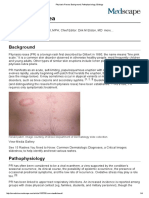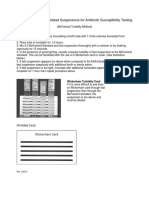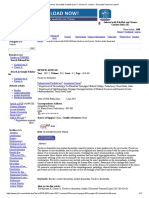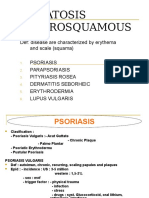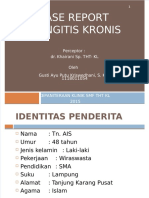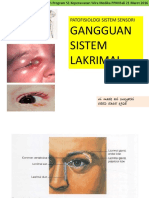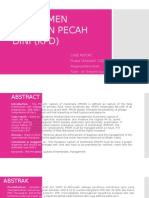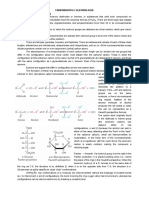Stryer Chapter 9 Carbohydrates
Stryer Chapter 9 Carbohydrates
Uploaded by
Dyamond SantiagoCopyright:
Available Formats
Stryer Chapter 9 Carbohydrates
Stryer Chapter 9 Carbohydrates
Uploaded by
Dyamond SantiagoOriginal Description:
Copyright
Available Formats
Share this document
Did you find this document useful?
Is this content inappropriate?
Copyright:
Available Formats
Stryer Chapter 9 Carbohydrates
Stryer Chapter 9 Carbohydrates
Uploaded by
Dyamond SantiagoCopyright:
Available Formats
Chapter 9 Carbohydrates
1. Draw the D and L-form of aldoses and ketoses that have three, four and six carbon atoms, Identify the stereocenter and the position that defines the sugar as being either the D or the L form. pecifically know the structures of glucose, fructose, glyceraldehyde, dihydroxyacetone.
!. "e able to identify constitutional isomers, enantiomers, epimers, diastereoisomers, anomers and stereoisomers.
#. "e able to cyli$e aldoses and ketoses given the fisher pro%ection diagrams into & and ' ring structures.
(. )now the reaction of monosaccharides* redox reactions
&. )now the derivatives of monosaccharides* e.g. sugar phosphates +, - ./012 - /,# +,! ./012, -3 /111-, -3 1-41#5!'. List disaccharides of importance* maltose, lactose and sucrose. "e able to identify the different linkages. 6altose* disaccharide obtained by en$yme-cataly$ed hydrolysis of starch, consists of two D-glucopyranoses %oined by a 1,(7-beta-glycoside bond. It7s a reducing sugar because the anomeric carbons on the right-hand sugar are part of a hemiacetal. 6altose is digested without difficulty and is fermented readily. Lactose* occurs naturally in both human and cow7s milk. 8idely used in baking and in commercial infant-milk formulas. It7s a reducing sugar and exhibits mutarotation and is a 1,(7-beta-linked glycoside. Lactose contains two different monosaccharide units and the acidic hydrolysis of lactose yields 1 e9uiv of Dglucose and 1 e9uiv of D-galactose: the two are %oined by a beta-glycoside bond between /1 of galactose and /( of glucose. ucrose* a flexible structure that7s the most abundant pure organic chemical in the world and the one most widely known to nonchemists. ;ields 1 e9uiv of glucose and 1 e9uiv of fructose on acidic hydrolysis. <his 1*1 mixture of glucose and fructose is often referred to as invert sugar, since the sign of optical rotation changes .inverts2 during the hydrolysis from sucrose .=alpha>D 0 ?''.°rees2 to a glucose fructose mixture .=alpha>D 0 -!!.@degrees2. +ot a reducing sugar and doesn7t exhibit mutarotation. Aacts imply that sucrose has no hemiacetal linkages and that glucose and fructose must both be glycosides. <his can happen only if the
two sugars are %oined by a glycoside link between /1 of glucose and /! of fructose. B. "e able to identify the differences between polysaccharides* starch, amylopectin, cellulose, glycogen. tarch* produced in plants as a way of storing energy and exists in two forms amylose and amylopectin. ,elical chain of glucose monomers, which are bonded by glycosidic linkages. C storage polysaccharide in plant cells, we can obtain starch from potatoes. Cmylopectin* is a branched polymer of alpha-glucose and is completely insoluble in water.
/ellulose* made exclusively by molecules of beta-glucose. /ellulose is the constituent of the cell walls in plant cells. "ecause of humans do not produce en$ymes which hydroly$e the cellulose, we cannot use it as a primary energy source .we cannot digest cellulose2. Dlycogen* the storage polysaccharide in animals. It7s also known as Eanimal starchF because of its similitude with amylopectin molecules, but glycogen is more branched than amylopectin. "esides, glycogen molecules are tighter than amylopectin molecules. ,umans can use glycogen as an energy source by hydrolysis of the polymer using specific en$ymes .organic substances that accelerate or retard the biochemical reactions2. G. "e able to recogni$e glycoproteins and their importance in blood groups. Cll blood groups have a deoxy sugar. <ype C* +-acetylgalactosamine <ype "* alpha-D-galactose <ype C"* both <ype 1* neither
H. "e able to recogni$e the important functions of carbohydrates ource of energy paring protein for tissue building and repairing Aat oxidation Iole in gastro-intestinal functions - lactose promotes the growth of certain desirable bacteria in the small intestine, which brings about the synthesis of certain "-complex vitamins. It also enhances the absorption of calcium. /ellulose provides fiber and bulk which helps in the stimulation of the peristaltic movements of the gastroinl tract. Important Terms and Comparisons 6onosaccharides, disaccharides and 1ligosaccharides Cldoses and ketoses Jpimers and epimeri$ation /hiral molecule Cnomeric /arbon atoms ,emiacetal and acetal Ieducing and +on-reducing sugar D and L -monosaccharides Aisher pro%ection and ,aworth structures Dlycosidic bond Auranose and pyranose Clpha and beta linkages
You might also like
- Price List SAP Per 01 Juni 2023 - 230511 - 141456Document2 pagesPrice List SAP Per 01 Juni 2023 - 230511 - 141456Esty Indah PNo ratings yet
- Tabel Konversi FiO2Document2 pagesTabel Konversi FiO2arie_yuliantoNo ratings yet
- Vitamina D y FertilidadDocument14 pagesVitamina D y FertilidadHenry BadillaNo ratings yet
- Lab ReportDocument6 pagesLab ReportAmanda IvesterNo ratings yet
- Tuberkulosis Anak: Dr. Dewi Angreany M.Ked (Ped), Sp.ADocument52 pagesTuberkulosis Anak: Dr. Dewi Angreany M.Ked (Ped), Sp.AIlham KurniawanNo ratings yet
- Gambar UlkusDocument5 pagesGambar UlkusMaria Margareta HutajuluNo ratings yet
- 13 - 266fourniers Gangrene PDFDocument5 pages13 - 266fourniers Gangrene PDFMochamad RizalNo ratings yet
- 25 Chabib Fachry AlbabDocument3 pages25 Chabib Fachry Albabfachry albabNo ratings yet
- Pityriasis Rosea - Background, Pathophysiology, EtiologyDocument4 pagesPityriasis Rosea - Background, Pathophysiology, EtiologysyahrulroziNo ratings yet
- Stages of Acute Otitis MediaDocument1 pageStages of Acute Otitis MediaNicole Marie NicolasNo ratings yet
- KriptorkismusDocument14 pagesKriptorkismusMutiara Prima DianaNo ratings yet
- McFarland Wickerham MethodDocument1 pageMcFarland Wickerham Methodali aimanNo ratings yet
- Template ReferatDocument2 pagesTemplate Referatniki_olah9508No ratings yet
- TUTOR 4 Ruptur Tendon AchilesDocument40 pagesTUTOR 4 Ruptur Tendon Achilesradiantx51No ratings yet
- Paederus Dermatitis Karthikeyan K, Kumar A - Indian J Dermatol Venereol LeprolDocument11 pagesPaederus Dermatitis Karthikeyan K, Kumar A - Indian J Dermatol Venereol Leprolalmas prawoto100% (1)
- Diabetic FootDocument27 pagesDiabetic Footnurul afiahNo ratings yet
- Kegawatan Respirasi May2016-FkumyDocument62 pagesKegawatan Respirasi May2016-FkumyAgustina Tri P. DNo ratings yet
- Anemia Ec Perdarahan Saluran CernaDocument13 pagesAnemia Ec Perdarahan Saluran CernaSiti Nur RachmaniNo ratings yet
- UTF-8''diarrhea 13-11-13Document32 pagesUTF-8''diarrhea 13-11-13yoga yogafenkanoNo ratings yet
- Laporan Kasus Sindroma NefrotikDocument13 pagesLaporan Kasus Sindroma NefrotikZenithaMeidaNo ratings yet
- CR Piopneumothoraks Nicky FIXdDocument62 pagesCR Piopneumothoraks Nicky FIXdPutri RahmawatiNo ratings yet
- Laporan Kasus Preeklampsia: Disusun Oleh: Dr. Muhammad Fadlan PulunganDocument1 pageLaporan Kasus Preeklampsia: Disusun Oleh: Dr. Muhammad Fadlan PulunganDebora Angelina TobingNo ratings yet
- Radiologi - Tambahan SsDocument91 pagesRadiologi - Tambahan SsShifa TifarinNo ratings yet
- Otitis Media AkutDocument31 pagesOtitis Media AkutNin DuskNo ratings yet
- Regulasi Dan Mekanisme EndokrinDocument121 pagesRegulasi Dan Mekanisme Endokrinluthfiyya syafiqaNo ratings yet
- Lapkas 4 - Pneumonia Susp. Covid 19-Fenda KhafidhotentyDocument17 pagesLapkas 4 - Pneumonia Susp. Covid 19-Fenda KhafidhotentydianarahimmNo ratings yet
- Corpus Alienum EsophagusDocument3 pagesCorpus Alienum EsophagusTrhey Ahmilza DamaitaNo ratings yet
- Dermatosis ErythrosquamousDocument16 pagesDermatosis ErythrosquamousVicky Ilda ViantiniNo ratings yet
- Case Report Faringitis Kronis: Perceptor: Dr. Khairani Sp. THT-KL Oleh G !ti A" P T Kri!#edhani$ S. Ked %%%&'%%'Document27 pagesCase Report Faringitis Kronis: Perceptor: Dr. Khairani Sp. THT-KL Oleh G !ti A" P T Kri!#edhani$ S. Ked %%%&'%%'Nisha NabilNo ratings yet
- Jurnal SinusitisDocument25 pagesJurnal SinusitisDwi Ayu NovianaNo ratings yet
- SINUS DentogenDocument24 pagesSINUS DentogenRadityaRezhaNo ratings yet
- Case Report ScabiesDocument28 pagesCase Report ScabiesPattiyahalatasNo ratings yet
- Blighted OvumDocument31 pagesBlighted OvumHeri FarnasNo ratings yet
- Hydronephrosis LWDocument8 pagesHydronephrosis LWvitauxianaNo ratings yet
- Demam Ruam: Della Rizki Anggilia 18105Document40 pagesDemam Ruam: Della Rizki Anggilia 18105Della Rizki AnggiliaNo ratings yet
- Pedoman Difficult Airway Society 2015 Untuk Manajemen Kesulitan Intubasi Yang Tak Terduga Pada DewasaDocument18 pagesPedoman Difficult Airway Society 2015 Untuk Manajemen Kesulitan Intubasi Yang Tak Terduga Pada DewasaAbdillahNo ratings yet
- Journal ReadingDocument18 pagesJournal ReadingnafisyarifahNo ratings yet
- Gangguan Sistem LakrimalDocument14 pagesGangguan Sistem LakrimalraiNo ratings yet
- Jurnal EntropionDocument7 pagesJurnal EntropionOgiesilaenNo ratings yet
- 7.ketuban Pecah Dini-PromDocument21 pages7.ketuban Pecah Dini-PromabcdshNo ratings yet
- IT 7 - Pendekatan Diagnostik Limfadenopati Limfadenitis - NDDocument46 pagesIT 7 - Pendekatan Diagnostik Limfadenopati Limfadenitis - NDRebeka Anastasia MarpaungNo ratings yet
- Jurnal Forensik Trauma KimiaDocument5 pagesJurnal Forensik Trauma Kimiaikram hanafiNo ratings yet
- Medical Tourism and Wellness - Hospitality Bridging Healthcare (H2H) - 2017-362.1rDocument481 pagesMedical Tourism and Wellness - Hospitality Bridging Healthcare (H2H) - 2017-362.1rLê Trần PhúcNo ratings yet
- Partus Spontam Pervaginam FixedDocument29 pagesPartus Spontam Pervaginam FixedRony ArzalNo ratings yet
- Diagnosis Banding Blok 23 Ulkus KorneaDocument16 pagesDiagnosis Banding Blok 23 Ulkus KorneaAnggia Lestari HdyNo ratings yet
- Komplikasi RhinosinusitisDocument54 pagesKomplikasi RhinosinusitisWilda Kamila SungkarNo ratings yet
- Referat Kandidosis Kutis - Dhira Dan A. Fari-70700120034 Dan 038Document14 pagesReferat Kandidosis Kutis - Dhira Dan A. Fari-70700120034 Dan 038Ahmad Fari Arief LopaNo ratings yet
- Babygram PDFDocument22 pagesBabygram PDFArtikelWanitaDanKehamilanNo ratings yet
- Abnormal Pupil, How To DoDocument8 pagesAbnormal Pupil, How To DoUNHAS OphthalmologyNo ratings yet
- Laporan Kasus Os Posterior Vitreous Detachment (Floaters) : Pembimbing: Dr. Minggaringrum, SP.MDocument8 pagesLaporan Kasus Os Posterior Vitreous Detachment (Floaters) : Pembimbing: Dr. Minggaringrum, SP.Malphonse yanuarNo ratings yet
- Abstract Book Konika XixDocument1,138 pagesAbstract Book Konika XixNurul Huda KowitaNo ratings yet
- Diagnosis Banding HFDocument2 pagesDiagnosis Banding HFIndah SariNo ratings yet
- Icd 10 Kasus Bedah SarafDocument8 pagesIcd 10 Kasus Bedah SarafHanda YaniNo ratings yet
- Appendecitis AcuteDocument40 pagesAppendecitis Acutekoernia swa oetomoNo ratings yet
- HbA1C AS AN INDEX OF GLYCEMIC STATUS IN OBESE TYPE 2 DIABETICSDocument6 pagesHbA1C AS AN INDEX OF GLYCEMIC STATUS IN OBESE TYPE 2 DIABETICSInternational Journal of Clinical and Biomedical Research (IJCBR)No ratings yet
- Borang Isian ISIPDocument50 pagesBorang Isian ISIPcamila anisNo ratings yet
- 10 - 258sepsis Neonatorum Awitan DiniDocument4 pages10 - 258sepsis Neonatorum Awitan DiniIrenaNo ratings yet
- Manajemen Ketuban Pecah Dini (KPD)Document13 pagesManajemen Ketuban Pecah Dini (KPD)Anonymous 7r6o3g4j100% (1)
- Hepatoma 1Document37 pagesHepatoma 1Syifa FadyaNo ratings yet
- Epimer of GlucoseDocument8 pagesEpimer of GlucoseMohammad BaberNo ratings yet
- Structure of Carbohydrates FinalDocument8 pagesStructure of Carbohydrates FinalAnonymous KeHF7wbhFNo ratings yet
- 54-Organic Pharmaceutical Chemistry Ii - 1Document6 pages54-Organic Pharmaceutical Chemistry Ii - 1Mohd AzharNo ratings yet
- Microwave Synthesis SolutionsDocument12 pagesMicrowave Synthesis SolutionsbekkuNo ratings yet
- TB Chapter18Document20 pagesTB Chapter18Ruchi Briam James LagitnayNo ratings yet
- Planning of Organic Synthesis 01Document22 pagesPlanning of Organic Synthesis 01Bapu ThoratNo ratings yet
- Worksheet For CarbsDocument6 pagesWorksheet For CarbsUzmaNabeelaNo ratings yet
- Importance of CarbohydrateDocument71 pagesImportance of CarbohydrateJasveen SainiNo ratings yet
- Synthesis of Bisphenol Z: An Organic Chemistry Experiment: Richard W. GregorDocument3 pagesSynthesis of Bisphenol Z: An Organic Chemistry Experiment: Richard W. GregorMariana DelgadoNo ratings yet
- Synthesis of IbuprofenDocument3 pagesSynthesis of IbuprofenSeven Dang100% (1)
- Lesson 14 CarbohydratesDocument35 pagesLesson 14 CarbohydratesAlthea Sachi CruzNo ratings yet
- Carbohydrates ActivityDocument3 pagesCarbohydrates ActivityJeckha ReyNo ratings yet
- Daphniphyllum Alkaloids Final MDPDocument15 pagesDaphniphyllum Alkaloids Final MDPSơn Nguyễn KimNo ratings yet
- Carbohydrates Worksheet 1Document2 pagesCarbohydrates Worksheet 1Omnia A. ElsharawyNo ratings yet
- Simple and Complex CarbohydratesDocument78 pagesSimple and Complex CarbohydratesRonald GyezahoNo ratings yet
- Carbohydrate WorksheetDocument2 pagesCarbohydrate Worksheetcdnarido7535valNo ratings yet
- Carbohydrate Identification Lab ReportDocument3 pagesCarbohydrate Identification Lab ReportAbby100% (1)
- Summary Carbohydrates and GlycobiologyDocument3 pagesSummary Carbohydrates and GlycobiologyIvan MiglioriniNo ratings yet
- Formal LabDocument4 pagesFormal Labljeanja2100% (1)
- Carbohydrates - I SAPANADocument49 pagesCarbohydrates - I SAPANASapana SubediNo ratings yet
- Unknown White Compound Lab ReportDocument8 pagesUnknown White Compound Lab ReportTyler Blevins100% (1)
- Strategies and Tactics in Organic Synthesis Lucidi - PapagniDocument472 pagesStrategies and Tactics in Organic Synthesis Lucidi - PapagnimcgilicuttyNo ratings yet
- Automated Parallel Polyurethane Dispersion Synthesis and CharacterizationDocument10 pagesAutomated Parallel Polyurethane Dispersion Synthesis and CharacterizationAmbadas GarjeNo ratings yet
- Chem113Lec-Activity 2-Carbohydrates ActivityDocument3 pagesChem113Lec-Activity 2-Carbohydrates ActivityAlliana Denice VicencioNo ratings yet
- Translation in Prokaryotes and EukaryotesDocument17 pagesTranslation in Prokaryotes and EukaryotesMuhammad Arslan YasinNo ratings yet
- Carbohydrates PostlabDocument37 pagesCarbohydrates PostlabThea MallariNo ratings yet
- Practical 1 - Qualitative Analysis of Carbohydrates-FinalDocument5 pagesPractical 1 - Qualitative Analysis of Carbohydrates-FinalDOUMBOUYA SIDIKINo ratings yet
- Work-Order UpdateDocument75 pagesWork-Order UpdateOPARA JOSIAHNo ratings yet
- Chem 224 Recitation 11 PDFDocument23 pagesChem 224 Recitation 11 PDFRichard Oletsky100% (1)
- Chemical Synthesis and Yield - SolutionsDocument8 pagesChemical Synthesis and Yield - Solutionstzarin372No ratings yet
- OriginalOrganicCompilation PDFDocument17 pagesOriginalOrganicCompilation PDFTech TipsNo ratings yet








